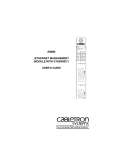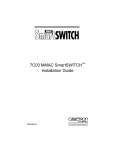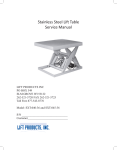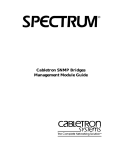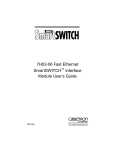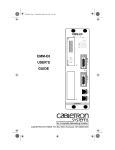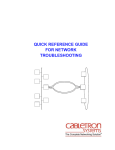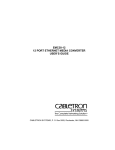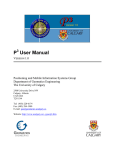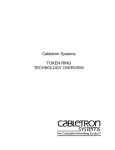Download Cabletron Systems EFDMIM Setup guide
Transcript
MMAC-M8FNB™ MULTI-MEDIA ACCESS CENTER OVERVIEW AND SETUP GUIDE CABLETRON SYSTEMS, P.O. Box 5005, Rochester, N.H. 03866-5005 NOTICE Cabletron Systems reserves the right to make changes in specifications and other information contained in this document without prior notice. The reader should in all cases consult Cabletron Systems to determine whether any such changes have been made. The hardware, firmware, or software described in this manual is subject to change without notice. IN NO EVENT SHALL CABLETRON SYSTEMS BE LIABLE FOR ANY INCIDENTAL, INDIRECT, SPECIAL, OR CONSEQUENTIAL DAMAGES WHATSOEVER (INCLUDING BUT NOT LIMITED TO LOST PROFITS) ARISING OUT OF OR RELATED TO THIS MANUAL OR THE INFORMATION CONTAINED IN IT, EVEN IF CABLETRON SYSTEMS HAS BEEN ADVISED OF, KNOWN, OR SHOULD HAVE KNOWN, THE POSSIBILITY OF SUCH DAMAGES. © Copyright December 1995 by Cabletron Systems, Inc. P.O. Box 5005 Rochester, NH 03866-5005 All Rights Reserved Printed in the United States of America Order number: 9030535-08 December 1995 SPECTRUM, LANVIEW, and Multi Media Access Center are registered trademarks and MMAC-M8FNB, MIM, M8PSM, M8PSM-E, and M8PSM-EDC are trademarks of Cabletron Systems, Inc. Ethernet is a trademark of Xerox Corporation. IBM is a registered trademark of International Business Machines Corporation i FCC NOTICE This device complies with Part 15 of the FCC rules. Operation is subject to the following two conditions: (1) this device may not cause harmful interference, and (2) this device must accept any interference received, including interference that may cause undesired operation. Note: This equipment has been tested and found to comply with the limits for a Class A digital device, pursuant to Part 15 of the FCC rules. These limits are designed to provide reasonable protection against harmful interference when the equipment is operated in a commercial environment. This equipment uses, generates, and can radiate radio frequency energy and if not installed in accordance with the operator’s manual, may cause harmful interference to radio communications. Operation of this equipment in a residential area is likely to cause interference, in which case the user will be required to correct the interference at his own expense. WARNING: Changes or modifications made to this device which are not expressly approved by the party responsible for compliance could void the user’s authority to operate the equipment. DOC NOTICE This digital apparatus does not exceed the Class A limits for radio noise emissions from digital apparatus set out in the Radio Interference Regulations of the Canadian Department of Communications. Le Présent appareil numérique n’émet pas de bruits radioélectriques dépassant les limites applicables aux appareils numériques de la class A prescrites dans le Règlement sur le brouillage radioélectrique édicté par le ministère de Communications du Canada. BABT NOTICE This device is approved under BABT General Approval No. NS/G/1234/J/100003 for indirect connection to public telecommunications systems in the United Kingdom. ii VCCI NOTICE This equipment is in the 1st Class Category (information equipment to be used in commercial and/or industrial areas) and conforms to the standards set by the Voluntary Control Council for Interference by Information Technology Equipment (VCCI) aimed at preventing radio interference in commercial and/or industrial areas. Consequently, when used in a residential area or in an adjacent area thereto, radio interference may be caused to radios and TV receivers, etc. Read the instructions for correct handling. iii iv CONTENTS CHAPTER 1 1.1 1.2 1.3 1.4 1.5 USING THIS MANUAL ............................................................ 1-1 1.1.1 Symbols.......................................................................... 1-2 USING THE MMAC-M8FNB MANUAL SET.......................... 1-2 GETTING HELP........................................................................ 1-3 THE MMAC-M8FNB MULTI MEDIA ACCESS CENTER ..... 1-4 MMAC-M8FNB FEATURES..................................................... 1-5 CHAPTER 2 2.1 2.2 2.3 2.4 2.5 INSTALLATION REQUIREMENTS AND SPECIFICATIONS SITE GUIDELINES................................................................... 2-1 MMAC-M8FNB CONFIGURATION GUIDELINES ............... 2-2 OPERATING SPECIFICATIONS............................................. 2-3 2.3.1 Physical Specifications.................................................. 2-3 2.3.2 Power Supply Requirements ........................................ 2-4 2.3.3 Test Points..................................................................... 2-7 LEDs ........................................................................................... 2-8 SAFETY.................................................................................... 2-12 CHAPTER 3 3.1 3.2 INTRODUCTION MMAC-M8FNB SETUP UNPACKING THE MMAC-M8FNB......................................... 3-1 SETTING UP THE MMAC-M8FNB ......................................... 3-2 3.2.1 Rack Mounting the MMAC-M8FNB Chassis .............. 3-2 3.2.2 Rack Mounting the Cable Tie Tray.............................. 3-4 3.2.3 Inserting the Fan Tray ................................................. 3-5 3.2.4 Installing the Power Supply Module............................ 3-6 3.2.5 Installing the Security Bars ......................................... 3-9 3.2.6 Powering Up the MMAC-M8FNB .............................. 3-10 v CONTENTS vi CHAPTER 1 INTRODUCTION The MMAC-M8FNB™ Multi Media Access Center offers maximum flexibility and convenience in the design and operation of your network. The enclosure provides space for one Repeater/Management Module and up to seven Media Interface Modules (MIM™), allowing up to 171 network connections depending on the Repeater/Management module and the MIMs that have been installed. This manual is an installation and reference guide. It lists the features and options of the MMAC-M8FNB and explains how to install the fan tray and power supply(ies). You should read through this manual prior to using the MMAC-M8FNB to gain a full understanding of the MMAC-M8FNB and its capabilities. Only qualified personnel should install or service this unit and its modules! 1.1 USING THIS MANUAL Chapter 1, Introduction, discusses the features and capabilities of the MMAC-M8FNB. Chapter 2, Installation Requirements and Specifications, lists the location requirements that must be met before you install the MMAC-M8FNB on your network. This chapter also includes some MIM configuration guidelines, environmental guidelines, and operating specifications for the MMAC-M8FNB and related Power Supply Modules (M8PSM™, M8PSM-E™, or M8PSM-EDC™). Page 1-1 INTRODUCTION Chapter 3, MMAC-M8FNB Setup, contains instructions for rack mounting your MMAC-M8FNB, inserting the fan tray, installing the power supply(ies), installing the security bars, and powering up the MMAC-M8FNB. 1.1.1 Symbols Throughout this manual you will see two symbols which will be used to call your attention to important safety-related information: CAUTION: when you see this symbol, you will be provided with special precautionary information that can help you guard against improper use of your equipment. WARNING: when you see this symbol, note that failure to follow the instructions provided can result in an electrical safety hazard. You will also see a third symbol, which will be used to call your attention to additional information not related to safety: NOTE 1.2 NOTE: the information that follows could help you to better use and understand your equipment. USING THE MMAC-M8FNB MANUAL SET Other manuals have been developed for the Repeater/Management modules and for each MIM that can be installed in your MMAC-M8FNB. These manuals explain how to install the individual Page 1-2 INTRODUCTION modules into the MMAC-M8FNB, how to attach cable segments to the modules, and how to test those segments after they have been installed. Specifications for all modules are included in each manual. Additional manuals have been developed on how to use Cabletron Systems’ Network Management software packages; these manuals include information about how to remotely manage the MMAC-M8FNB and the M8PSM-E and M8PSM-EDC power supply modules. Each manual in this set assumes that you have a general working knowledge of Ethernet or IEEE 802.3, 802.5, and FDDI type data communications networks and their physical layer components. 1.3 GETTING HELP If you need additional support related to the MMAC-M8FNB, or if you have any questions, comments, or suggestions related to this manual, contact Cabletron Systems Technical Support. Before calling, please have the following information ready: • The product type (MMAC-M8FNB), and the product serial number. The serial number is located on the front panel of the MMAC, and the product type is on the fan tray label. Also, be sure to note which power supply module or modules you have installed: the M8PSM, the M8PSM-E, and/or the M8PSM-EDC. You can contact Cabletron Systems’ Technical Support Department by any of the following methods: By phone: Monday through Friday between 8 A.M. and 8 P.M. Eastern Standard Time at (603) 332-9400. By Mail: Cabletron Systems, Inc. PO Box 5005 Rochester, NH 03866-5005 By CompuServe®: GO CTRON from any ! prompt Page 1-3 INTRODUCTION 1.4 By Internet mail: [email protected] By FAX: (603) 337-3075 By BBS: (603) 335-3358 (4 lines available) THE MMAC-M8FNB MULTI MEDIA ACCESS CENTER The Cabletron Systems MMAC-M8FNB is a complete modular approach to integrated networks. The MMAC-M8FNB supports Local Area Networks compliant to IEEE 802.3, IEEE 802.5, and FDDI standards. It also supports all of the Cabletron Systems Media Interface Modules (MIMs). Figure 1-1 below illustrates an MMAC-M8FNB equipped with a variety of MIM cards. TRMIM-22A TRMIM-22A TRMIM-4A SN SN 16MB LNK PEN ERR MGMT 16MB LNK PEN 1 X 2 X 3 X 4 X 5 X 6 X 1 X 2 X 3 X 4 X 5 X 6 X 1 X 2 X 3 X 4 X 5 X 6 X 7 X 8 X 9 X 10 X 11 X 12 X 7 X 8 X 9 X 10 X 11 X 12 X 7 X 8 X 9 X 10 X 11 X 12 X ACTIVE UTP TOKEN RING EFDMIM SN LNK PEN ERR MGMT ACTIVE UTP TOKEN RING STAND BY POWER MGMT 16MB RI RO CRS16 WFLT WRAP FO FLNK SYS OK SN ETHERNET TX RX COL POK 4 3 2 1 B Y P A S S 15 16 17 18 19 20 21 22 23 24 25 26 CLN CLN 2 3 4 5 6 7 8 9 10 11 12 13 R L C N V K R L C N V K ERR STBYA STBYC STBYB STBYD RCVA RCVB RCVC RCVD ON CLNA CLNB CLNC CLND PWR A U I R L C N V K 1 TX I N RX 14 1 14 1 14 1 F D D I ON PWR A U I A 2 R I N G TX O U T 13 26 13 26 13 M O D E M C O N S O L E F D D I B RX ACTIVE UTP TOKEN RING 26 LINK 15 FDDI 2 10BASE-T ETHERNET 15 2 10BASE-T ETHERNET 15 2 10BASE-T ETHERNET MMAC-M8FNB Multi Media Access Center The Complete Networking Solution™ Figure 1-1. MMAC-M8FNB with Installed MIMs Page 1-4 BOK CLN AUI POK 15 16 17 18 19 20 21 22 23 24 25 26 2 3 4 5 6 7 8 9 10 11 12 13 R L C N V K R L C N V K RESET B C CLN AUI POK 15 16 17 18 19 20 21 22 23 24 25 26 2 3 4 5 6 7 8 9 10 11 12 13 R L C N V K SN ETHERNET B C CLN AUI POK F M D M D A I C ON NET SN ETHERNET B C CLN TX RX WRAP TOKISD R I N G TPRMIM-36 TPRMIM-36 TPRMIM-36 EMME SN SN ERR C O N S O L E ETHERNET INTRODUCTION A variety of IEEE 802.3, IEEE 802.5, and FDDI compliant media can be connected to the MMAC-M8FNB, including shielded and unshielded twisted pair, fiber optic cable, thick or thin coaxial cable, and standard AUI transceiver cable. Each media type has a MIM which, when installed into the MMAC-M8FNB, is compatible with all other MIMs installed in that unit. The MMAC-M8FNB provides complete network integration of a variety of media through a single source. The MMAC-M8FNB is designed so that network expansions or changes in media types can be done without bringing down the entire network — in a matter of minutes, you can add, change, or replace MIMs without turning off the MMAC-M8FNB or using any special tools. This design also allows the MMAC-M8FNB to continue to adapt to ever-changing industry standards. 1.5 MMAC-M8FNB FEATURES Three Power Supply Modules to Choose From The MMAC-M8FNB chassis supports three different power supply modules: the original M8PSM, the M8PSM-E enhanced model, and the new M8PSM-EDC, an enhanced model that accepts DC power input. In addition to all of the features of the M8PSM, the M8PSM-E and -EDC enhancements include higher power output (450 watts — a 50% increase over the standard 300 watts), internal cooling (two fans are located within the module itself), power factor correction (M8PSM-E only), and remote management. Auto-Ranging Power Supply The M8PSM and M8PSM-E sense and automatically adjust to the input voltage and frequency. No additional adjustments are necessary. Built-in Power Supply Protection The M8PSM, M8PSM-E, and M8PSM-EDC power supply modules automatically power down under any of the following conditions: thermal overload (thermal protection); shorted output (over current or Page 1-5 INTRODUCTION short circuit protection); or excess output voltage (over voltage protection). The power supply will automatically recover when a thermal overload condition is corrected; when an over current or over voltage condition is corrected, the power supply requires power cycling (turn power switch off, then on again) to recover. A FAULT LED on the power supply modules indicates when an over current condition has occurred. Power Factor Correction The M8PSM-E meets the EN60555-2 limits for power factor correction, which may be required by utility companies in the near future. The power factor correction feature provides a number of advantages. By improving this factor to meet the EN60555-2 limits, line noise and peak current levels are dramatically reduced and the amount of power available to the user is increased. Power factor correction also reduces stress on fuses, circuit breakers, wall sockets, wiring, and transformers. Power OK Signal On the M8PSM, the same signal that illuminates the Power OK LED on the power supply module will also alert the management module that the power supply is functioning normally. The M8PSM-E and -EDC have both red and green power LEDs; power supply status as indicated by the LEDs will also be sent to the management module. Redundant Power with Load Sharing Depending on the power requirements of the installed MIMs, the MMAC-M8FNB can operate with either one or two power supply modules. If two power supplies are installed, they share the power load requirements of the installed MIMs; if one power supply fails, the second automatically assumes the entire load if it is able. This ensures that your network will remain operational until a replacement power supply module can be installed. Page 1-6 INTRODUCTION Any two matching power supply modules (i.e., two M8PSMs, two M8PSM-Es, or two M8PSM-EDCs) will use a current sharing scheme such that each power supply provides 50% of the required load (±5%, 5V output only) under all load conditions; if you have one M8PSM and one M8PSM-E installed, the M8PSM-E will supply 60% of the required power, and the M8PSM will supply the remaining 40%. Note that, if you have an M8PSM and an M8PSM-E installed in the same chassis, the redundancy LED on the M8PSM-E will not function. Note, too, that you cannot mix AC (M8PSM or M8PSM-E) and DC (M8PSM-EDC) power supplies in the same hub. NOTE The power requirements of some FDDI MIM configurations require dual power supplies. Consult the appropriate manuals for details. Hot Swapping You have the option to “hot swap” power supply modules in the M8FNB. This allows you to remove or insert power supplies without powering down the M8FNB. Internal Power Supply Cooling The M8PSM-E and -EDC enhanced power supplies have two fans built directly into the unit to provide additional cooling; red and green FAN LEDs on the power supply’s front panel indicate whether all fans are operational (green) or one or more has failed (red). Power Level Indicator The M8PSM-E and -EDC also include an 11-segment LED to indicate the level of power currently being used by the chassis. Each illuminated segment represents 10% of the maximum output; the eleventh segment, when lit, indicates an overload condition. Note that, if any one power supply is providing more than 50% of its available power, there is no power supply redundancy available in the chassis. Page 1-7 INTRODUCTION NOTE In a system in which two power supplies are installed and each is using more than 50% power, LED segments 5-9 will illuminate yellow, warning of the loss of redundancy. Remote Management The remote management capability built in to the M8PSM-E and -EDC allows the network manager to determine whether or not an installed power supply is an E-series model and whether or not power supply redundancy is available; the M8PSM-Es and -EDCs can also be remotely disabled if an emergency shutdown is required. Power supply redundancy is available when two power supplies are installed in your hub and when neither one is supplying more than 50% of its available power; this applies even when one M8PSM and one M8PSM-E are combined in the same hub. (You cannot mix AC [M8PSM or M8PSM-E] and DC [M8PSM-EDC] power supplies in the same hub.) NOTE Page 1-8 For access to remote management features, your MMAC-M8FNB must have the correct backplane version (chassis revisions EL and above) and you must have a Cabletron management module which supports the M8PSM-E and -EDC. Note also that, although the redundancy feature will function as described above, the redundancy LEDs will not illuminate unless you have two E-series power supplies installed and your hub has the correct backplane. Contact Cabletron Systems Technical Support for more information. INTRODUCTION Removable Fan Tray The MMAC-M8FNB is equipped with a removable fan tray, which means that you can replace a failed fan unit quickly, without any special tools. The fan tray incorporates an LED that indicates fan status; the same signal that illuminates the LED also alerts the management module that the fans are operating properly. The fan tray is hot-swappable; however, the MMAC chassis should not be run for extended periods of time without the fans installed, as it will quickly overheat. Flexible Network Bus The MMAC-M8FNB’s Flexible Network Bus allows the installed power supplies to load share; it also allows Token Ring or FDDI modules to communicate with one another, and to co-exist with Ethernet modules in the same hub. Cabletron Systems offers a full line of media interface modules that let you create new networks and extend and connect existing networks. Rack Mountable Chassis The MMAC-M8FNB chassis can be mounted into a standard 19" (48.26 cm) equipment rack. For safety and ease of network connections, separate rack mount brackets are included that allow the unit to be either flush mounted or recessed 3" from the front plane of the rack mount unit. Security Bars A pair of security bars which fit over the knurled knobs that secure the MIMs to the chassis protect the hub from unauthorized removal or insertion of modules. Page 1-9 INTRODUCTION Page 1-10 CHAPTER 2 INSTALLATION REQUIREMENTS AND SPECIFICATIONS This chapter describes the following: • Site guidelines that must be met before installing an MMAC-M8FNB onto your network • MMAC configuration guidelines • Operating specifications for the MMAC-M8FNB enclosure and power supply module Only qualified personnel should install or service this unit and its modules. 2.1 SITE GUIDELINES The following guidelines must be followed when you select a site for the MMAC-M8FNB; if they are not, unsatisfactory network performance may result. • An unrestricted free surface area of 53.3 cm (21 in.) wide, 62.2 cm (24.5 in.) deep and 44.5 cm (17.5 in.) high is needed for the MMAC-M8FNB enclosure. • If the MMAC-M8FNB is to be placed on a shelving unit, the shelf must be able to support 33.8 kg (75 lb.) of static weight. • If the MMAC-M8FNB is to be rack-mounted, care must be taken to ensure that the rack used will support the unit and that the rack remains stable with the MMAC-M8FNB installed. In order to allow proper Page 2-1 INSTALLATION REQUIREMENTS AND SPECIFICATIONS cooling within the rack, there must be 7.6 cm (3 in.) of clearance above the unit and 5 cm (2 in.) of clearance on either side of the unit. 2.2 • For the M8PSM and M8PSM-E power supplies, a USA standard 3 prong power receptacle must be located within 2.13 meters (7 feet) of the site. Each M8PSM-EDC power supply requires a positive or negative DC power source at 36-72 volts which is capable of supplying 17 amps. • The temperature of the location must be maintained between 5° and 40°C (41° to 104°F). Temperature changes of greater than 10°C (18°F) per hour must not occur. MMAC-M8FNB CONFIGURATION GUIDELINES The MMAC-M8FNB has eight slots that accept media interface modules. The slots are numbered from right to left; slot #1 is a half-width slot that is reserved for a management module. Cabletron Systems management modules are equipped with a firmware-based management tool called Local Management, which lets you control the MMAC MIMs. Management modules are also SNMP compliant, which means that an MMAC equipped with a management module can be managed remotely by SNMP management software (such as any one of Cabletron Systems’ SPECTRUM® for Open Systems suite of management products.) The M8PSM-E and -EDC power supply modules can also be managed remotely using appropriate management software. You can combine Token Ring, Ethernet, and FDDI MIMs in the same MMAC; be sure to consult the appropriate management module and MIM installation guides for detailed setup information. Page 2-2 INSTALLATION REQUIREMENTS AND SPECIFICATIONS 2.3 OPERATING SPECIFICATIONS The following lists the specifications for the MMAC-M8FNB enclosure and for the M8PSM, M8PSM-E, and M8PSM-EDC power supplies. Cabletron Systems reserves the right to change these specifications without notice. 2.3.1 Physical Specifications M8FNB Dimensions: 14.5" high x 17" wide x 19" deep (36.8 cm high x 43.2 cm wide x 48.3 cm deep) Weight: 19 lb (8.6 kg) with fan tray M8PSM Dimensions: 9.6" high x 8.1" wide x 3" deep (24.4 cm high x 20.6 cm wide x 7.6 cm deep) Weight: 5.75 lb (2.6 kg) M8PSM-E Dimensions: 9.6" high x 8.1" wide x 6" deep (24.4 cm high x 20.6 cm wide x 15.2 cm deep) Weight: 8.5 lb (3.9 kg) M8PSM-EDC Dimensions: 9.6" high x 8.1" wide x 6" deep (24.4 cm high x 20.6 cm wide x 15.2 cm deep) Weight: 8 lb (3.6 kg) Page 2-3 INSTALLATION REQUIREMENTS AND SPECIFICATIONS 2.3.2 Power Supply Requirements M8PSM The M8PSM power supply senses and automatically adapts to the input voltage and frequency. Input Frequency: 50/60 Hz Input Voltages & Current: 100 to 125 Vac, 5A 200 to 250 Vac, 2.5A Fuses: One 250 V, 10 Amp fuse (not user serviceable) BTUs/Hour: 1575.2 Table 2-1. Output Voltage Specifications: M8PSM NOTE Output Voltage (Vdc) Minimum Load (amps) Maximum Load (amps) Maximum Power (watts) +5 (±5%) 3 40 200 +12 (±5%) 0 5 60 -5 (±5%) 0 2 10 -9 (±5%) 0 11 99 The maximum power out of each M8PSM power supply will not exceed 300 watts. The mains cord used with this equipment must be a two-conductorplus-ground type with minimum 1 mm2 conductors and must incorporate a standard IEC appliance coupler on one end and a mains Page 2-4 INSTALLATION REQUIREMENTS AND SPECIFICATIONS plug on the other end which is suitable for the use and application of the product and that is approved for use in the country of application. These units are intended for indoor use only. M8PSM-E The M8PSM-E power supply senses and automatically adapts to the input voltage and frequency. Input Frequency: 50/60 Hz Input Voltages & Current: 100 to 125 Vac, 8A 200 to 250 Vac, 4A Fuses: One 250V, 12 Amp fuse (not user serviceable) BTUs/Hour: 2362.8 Table 2-2. Output Voltage Specifications: M8PSM-E NOTE Output Voltage (Vdc) Minimum Load (amps) Maximum Load (amps) Maximum Power (watts) +5 (±5%) 3 60 300 +12 (±5%) 0 10 120 -5 (±5%) 0 2 10 -9 (±5%) 0 15 135 The maximum power out of each M8PSM-E power supply will not exceed 450 watts. Page 2-5 INSTALLATION REQUIREMENTS AND SPECIFICATIONS The mains cord used with this equipment must be a two-conductorplus-ground type with minimum 1 mm2 conductors and must incorporate a standard IEC appliance coupler on one end and a mains plug on the other end which is suitable for the use and application of the product and that is approved for use in the country of application. These units are intended for indoor use only. M8PSM-EDC The M8PSM-EDC features polarity detection on the DC input; if the unit has been incorrectly installed and polarity is reversed, an internal buzzer will sound alerting the user to take corrective action. Input Voltages & Current: 36 to 72 Vdc, 17A Fuses: One 250 V, 20 Amp fuse (not user serviceable) BTUs/Hour: 2362.8 Table 2-3. Output Voltage Specifications: M8PSM-EDC NOTE Page 2-6 Output Voltage (Vdc) Minimum Load (amps) Maximum Load (amps) Maximum Power (watts) +5 (±5%) 3 60 300 +12 (±5%) 0 10 120 -5 (±5%) 0 2 10 -9 (±5%) 0 15 135 The maximum power out of each M8PSM-EDC power supply will not exceed 450 watts. INSTALLATION REQUIREMENTS AND SPECIFICATIONS These units are intended for indoor use only, and must be used with a user-supplied two-conductor-plus-ground cable with minimum 3 mm2 diameter conductors and terminated with #6 ring terminals. Cable must contain minimum 10 AWG wire. To reduce the risk of electric shock or energy hazards, install the M8PSM-EDC according to the following guidelines: 1. Connect to a positive or negative 48Vdc SELV source which is reliably connected to earth ground. 2. The branch circuit overcurrent protection must be rated 20A. 3. Use 10 AWG solid copper conductors only. 4. Disconnect both input supply sources before servicing. 5. A readily accessible disconnect device that is suitably approved and rated, shall be incorporated in the field wiring. 6. MMAC-M8FNB is to be installed in a restricted access area in accordance with the national electric code or the authority having jurisdiction. 2.3.3 Test Points Each power supply module has service-accessible test points for measuring each output, as well as for testing the power fail indication signal (see Tables 2-1, 2-2, and 2-3, above). Test points can measure each individual unit even when it is installed in parallel with another unit. Page 2-7 INSTALLATION REQUIREMENTS AND SPECIFICATIONS NOTE The power supply test points represent the power supply output voltages and not the bus voltage seen by the Media Interface Modules. The voltages measured at the test points are one diode voltage drop above the bus voltage. The following are the voltage tolerances which ensure that the bus voltage is within specified limits: +5 V test +12 V test -5 V test -9 V test 5.10 V to 5.75 V 11.75 V to 13.10 V -5.10 V to -5.75 V -8.90 V to -10.05 V Power Fail Indication: 2.4 Power good <1 V Power bad >4 V LEDs Power OK (Power Supply) When lit, this green LED indicates that the power supply module is operating correctly; a signal is also sent to the management/repeater module to indicate that the power supply is functioning properly. Power Fail (Power Supply) When lit, this red LED indicates a loss of input power, loss of regulation on any output, or the activation of any power fail circuit protection. NOTE Page 2-8 On the M8PSM-E and -EDC, the above-described Power OK and Power Fail LEDs are simply labeled “Power.” When the green LED is illuminated, the power supply is operating correctly, as described in Power OK, above; the red LED indicates the same trouble conditions described in Power Fail, above. INSTALLATION REQUIREMENTS AND SPECIFICATIONS POWER OK FAIL M8PSM +5 VOLT TEST -5 VOLT TEST SN +12 VOLT TEST -9 VOLT TEST COMMON POWER FAIL INDICATION POWER LEVEL FAULT POWER REDUNDANCY OL 100% FAN DISABLE 50% 100 - 125 ~ 8A 200 - 250 ~ 5A 50/60 Hz 10% SN POWER LEVEL 100 - 125 ~ 8A 200 - 250 ~ 5A 50/60 Hz FAULT POWER REDUNDANCY OL 100% FAN DISABLE 50% 10% SN FAULT Figure 2-1. The M8PSM, M8PSM-E, and M8PSM-EDC Page 2-9 INSTALLATION REQUIREMENTS AND SPECIFICATIONS Power Fail (Power Supply) NOTE When lit, this red LED indicates a loss of input power, loss of regulation on any output, or the activation of any power fail circuit protection. On the M8PSM-E and -EDC, the above-described Power OK and Power Fail LEDs are simply labeled “Power.” When the green LED is illuminated, the power supply is operating correctly, as described in Power OK, above; the red LED indicates the same trouble conditions described in Power Fail, above. Fault (Power Supply) When lit, this red LED indicates that an over current (short circuit) condition has occurred; this condition could result from inadequate power to the hub (only one power supply installed where two are required), or from a problem in the chassis itself. Once the over current condition has been corrected, the power supply requires power cycling (turn the power switch off for at least ten seconds, then on again) to recover. Redundancy (E-series only) A green LED indicates that two E-series power supplies are installed in a chassis with the correct backplane (chassis revisions EL and above) and that redundancy is available (neither power supply operating at more than 50% output); a red LED indicates that two E-series power supplies are installed in a chassis with the correct backplane and the redundancy is not available (each power supply operating at greater than 50% output). If neither LED is lit, an M8PSM-E has been installed in the same chassis as an M8PSM, or the chassis has an older backplane and must be upgraded to fully use the E-series features. Page 2-10 INSTALLATION REQUIREMENTS AND SPECIFICATIONS NOTE Even if neither LED is lit, redundancy is still available if neither power supply is operating at more than 50% output. This is true even when one M8PSM and one M8PSM-E are installed in the same chassis. Fan (E-series only) A green LED indicates that all fans inside the M8PSM-E or -EDC module are operating properly; a red LED indicates that one or more has failed. Disable (E-series only) If this red LED is illuminated, the power supply has been disabled remotely. Power Level (E-series only) When illuminated, each of the first ten segments of this LED indicates that 10% of total power output is being used; the eleventh segment, when illuminated, indicates a power overload. Note that, in a redundant system, segments 5-9 will illuminate yellow to warn of loss of redundancy. Fan Tray LED (Chassis) This LED is green when all the fans are operating properly; it turns red when any fan slows to half speed or less, and signals the management/repeater module that there is a fan tray problem. Note that this LED will also turn red when the fan tray board’s logic has failed due to a blown fuse; in this case, all fans may still be operating. NOTE When the M8FNB is first powered up, this LED will be red briefly until the fans are operating at the proper speed. Also, don’t confuse this fan tray LED (located on the front of the fan tray installed at the bottom of the chassis) with the Fan LED on the front panel of the M8PSM-E and -EDC. This fan tray LED indicates the operating status of the fans in the MMAC chassis; the Fan LED on the M8PSM-E and -EDC indicates the status of the fans inside the power supply itself. Page 2-11 INSTALLATION REQUIREMENTS AND SPECIFICATIONS 2.5 SAFETY Designed in accordance with UL1950, CSA C22.2 No. 950, IEC950, and EN 60950. Meets the EMI requirements of FCC Part 15 Class A, VCCI Class I, and EN 55022 Class A. Meets the immunity requirements of EN 50082-1. In addition, the MMAC-M8FNB chassis and the M8PSM-E and M8PSM-EDC power supplies have been tested by Bellcore and found to comply with the following standards: • TR-NWT-000063 Network Equipment Building System (NEBS) Generic Equipment Requirements • GR-1089-CORE EMC and Electrical Safety Generic Criteria for Network Telecommunications Equipment This unit must be assembled and used in accordance with the instructions in this manual. NOTE Page 2-12 It is the responsibility of the person who sells the system of which the MMAC-M8FNB will be a part to ensure that the total system meets allowed limits of conducted and radiated emissions. CHAPTER 3 MMAC-M8FNB SETUP This chapter contains instructions to help you set up Cabletron Systems’ MMAC-M8FNB. You will not need any special tools or equipment to set up the MMAC-M8FNB, but you must follow all guidelines listed in Chapter 2, Installation Requirements and Specifications. Only qualified personnel should install or service this unit and its modules. 3.1 UNPACKING THE MMAC-M8FNB Before you install the MMAC-M8FNB, you should inspect the unit. To unpack the MMAC-M8FNB: 1. Remove the MMAC-M8FNB and fan tray from the shipping box. Save the shipping box and materials in the event the MMAC-M8FNB has to be reshipped. 2. Slide the two foam end caps off the MMAC-M8FNB, and remove the unit from the protective plastic bag. Set the MMAC-M8FNB aside in a safe place. 3. Remove the accessory package and verify that it contains two mounting brackets, a cable tie tray, and two security bars. Contact Cabletron Systems Technical Support immediately if any discrepancy exists. Page 3-1 MMAC-M8FNB SETUP 3.2 SETTING UP THE MMAC-M8FNB The following sections list the steps necessary to set up your MMAC-M8FNB, including installing the MMAC-M8FNB in the desired location, inserting the fan tray, inserting the power supply module(s), and installing the security bars. 3.2.1 Rack Mounting the MMAC-M8FNB Chassis To mount the MMAC-M8FNB in a standard 19" equipment rack: 1. Using a Phillips head screwdriver, remove the eight screws (item 1, Figure 3-1) – four on each side of the MMAC-M8FNB – which are closest to the front of the chassis, and set them aside. 2. The rack mount brackets (item 2) provided have two sets of holes: use the front holes (item 3) to mount the chassis flush with the equipment rack; use the rear holes (item 4) to mount the chassis so that it is recessed 3" from the front of the rack. Align the appropriate four holes on one rack mount bracket with the four holes from which you removed the screws. 3. Insert the screws through the holes on the mounting bracket and into the screw holes on the MMAC-M8FNB. 4. Tighten the screws until the mounting bracket is securely attached to the unit. 5. Repeat steps 2-4 for the second rack mount bracket. Be sure to use the same set of holes on the second rack mount bracket (front for flush mount, rear for recessed mount) that you used on the first bracket. 6. Slide the unit into the rack, being sure to leave sufficient room to install the cable tie tray, if desired. Page 3-2 MMAC-M8FNB SETUP MMAC-M8FNB Multi Media Access Center The Complete Networking Solution™ 1 4 2 5 1. 2. 3. 4. 5. 6. 3 6 Screws (8 total; 4 each side) Rack mount bracket Holes for flush mount Holes for recessed mount Bolts (secure with locking washers) Equipment Rack Figure 3-1. Installing the M8FNB into a Rack 7. Align the slots on each mounting bracket with the desired holes on the equipment rack. 8. Insert a bolt (item 5) through the slot in each of the mounting brackets and into the threaded holes in the equipment rack (item 6). Secure bolts with locking washers. 9. Tighten the nuts and bolts until the unit is secured to the rack. Page 3-3 MMAC-M8FNB SETUP 3.2.2 Rack Mounting the Cable Tie Tray A cable tie tray is provided with the MMAC-M8FNB to support and organize cables connected to the unit. The tray is designed to be installed under the MMAC-M8FNB in the equipment rack. To mount the cable tray in a standard 19" equipment rack: 1. Slide the cable tie tray (Figure 3-2) into the rack. 2. Align the slots on each mounting bracket on the tray with the desired holes on the equipment rack. 3. Insert a bolt through the slots in each of the mounting brackets and into the threaded holes in the equipment rack. Use nuts with locking washers to secure the bolts. 4. Tighten the nuts and bolts until the tray is secured to the rack. MMAC-M8FNB Multi Media Access Center The Complete Networking Solution™ Figure 3-2. Cable Tie Tray Installation Page 3-4 MMAC-M8FNB SETUP 3.2.3 Inserting the Fan Tray The MMAC-M8FNB is equipped with a removable fan tray that allows for easy periodic cleaning and/or replacement if a problem occurs with fan operation. To insert the fan tray in the MMAC-M8FNB: 1. Hold the fan tray as shown in Figure 3-3 (following page) and align the slotted paths on the tray with the slot guides on the left and right walls of the MMAC-M8FNB chassis. 2. Slide the fan tray forward until the tray’s face is flush with the face of the MMAC-M8FNB. If you encounter any strong resistance, remove the fan tray and reinsert it. Do not force the fan tray into place as this may damage the unit. 3. Once the tray is in place, tighten the knurled knobs to secure the tray to the MMAC-M8FNB. 4. When the MMAC-M8FNB is ready to be turned on, observe the LED on the front of the fan tray. This LED should be red for a moment after you turn on the power switch, and then change to green to indicate that all the fans are operating properly. If this LED remains red, it indicates that one or more of the fans is not operating at the proper speed. Check the fan tray to ensure that nothing is interfering with movement of the fans; also, check to make sure nothing is blocking the air vents on the chassis or the fan tray. If you cannot find the problem, call Cabletron Systems Technical Support for assistance. The fan tray is hot-swappable; however, the chassis must not be run without the fan tray for extended periods of time, as it will quickly overheat. Page 3-5 MMAC-M8FNB SETUP MMAC-M8FNB Multi Media Access Center The Complete Networking Solution™ Slot guide Knurled knob Fan tray LED Figure 3-3. Inserting the Fan Tray 3.2.4 Installing the Power Supply Module You must install at least one power supply module in your MMAC-M8FNB. One MMAC-M8PSM provides sufficient power for many MIM configurations, but you may choose to install the more powerful M8PSM-E for some MIM configurations, or the M8PSM-EDC for use with a DC power source; with any model, you can also install a second power supply as a redundant and/or load-sharing power source. (Note that the power requirements of some FDDI configurations require dual power supplies.) When two power supply modules are installed, the load is evenly distributed; if one power supply fails for any reason other than a shorted DC backplane, the second power supply assumes the load, if it can, even when one M8PSM and one M8PSM-E are installed in the same chassis. An M8PSM-EDC power supply cannot be installed in the same chassis as an M8PSM or M8PSM-E. Page 3-6 MMAC-M8FNB SETUP The MMAC-M8FNB power supply modules are installed in the slots in the rear of the MMAC-M8FNB chassis (Figure 3-4). If you intend to install a single power supply module, the single module can be installed in either the left or the right slot; be sure to leave the empty power supply slot covered. Install the power supply module(s) into your MMAC-M8FNB as follows: 1. Unpack the power supply module by removing it from the shipping box and sliding the two foam end caps off the unit. Save the shipping box and materials in the event the unit must be reshipped. 2. Remove the power supply from its protective plastic bag. 3. If you plan to install two power supplies, use a screwdriver to loosen the knurled knobs securing the panel covering one of the power supply slots, and remove the panel. If you plan to install only a single power supply, it can be installed in either slot; remove the panel if necessary to uncover the desired slot, and replace the panel on the slot you plan to leave empty. POWER OK FAIL The Complete Networking Solution M8PSM +5 VOLT TEST -5 VOLT TEST SN +12 VOLT TEST -9 VOLT TEST COMMON POWER FAIL INDICATION FAULT 100 - 125 ~ 8A 200 - 250 ~ 5A 50/60 Hz 115-230V~ 8A 8A 115-230V~ 50/60 Hz Hz 50/50 115-230V ~ 8A 50/60 Hz Figure 3-4. Installing the Power Supply Module(s) Page 3-7 MMAC-M8FNB SETUP 4. Slide the power supply into the appropriate slot of the MMAC-M8FNB as follows: a. Hold the module by the two handles on its front panel. b. Align the power supply module with the slotted paths on the top and bottom of the opening. c. Ensuring that the power supply is inserted into the slotted paths, carefully slide the module forward until the module is connected to the backplane. Do not force the module into place! If you encounter significant resistance, remove the power supply and reinsert it. NOTE When properly installed, the face of the M8PSM power supply module will be flush with the rear panel of the MMAC chassis; the face of the M8PSM-E or -EDC, however, will extend about 3” out from the rear panel. 5. Use as screwdriver to tighten the knurled knobs and secure the power supply module to the chassis. 6. If you are installing an additional power supply module, repeat steps 3 - 5. NOTE One M8PSM and one M8PSM-E can be combined in a single chassis, without loss of functionality; however, the Redundancy LEDs on the M8PSM-E will not operate. See Chapter 2 for more details. Note, too, that you cannot install an M8PSM-EDC in the same chassis as either of the AC power modules. After you have finished installing the power supply module(s), the MMAC-M8FNB is ready to be powered up; however, we recommend that you first install the repeater/management module and the MIM or MIMs, as well as the security bars. Refer to the applicable module manuals for more information about MIM installation; see below for security bar installation and power-up instructions. Page 3-8 MMAC-M8FNB SETUP 3.2.5 Installing the Security Bars The MMAC-M8FNB is equipped with security bars to prevent unauthorized access to the hub and its installed modules. Two security bars have been provided: one to cover the top row of knurled knobs securing the modules to the chassis, and one to cover the bottom row of knobs. To attach the security bars to the chassis: 1. Install all MIMs in the M8FNB hub, as desired; be sure to install panels over any empty slots. 2. Place one of the security bars across the top row of knurled knobs securing the modules and panels to the chassis; align the screws in the security bar with the holes in the chassis (as illustrated in Figure 3-5), and tighten the screws. Repeat the procedure with the second security bar, using it to cover the bottom row of knurled knobs. Page 3-9 MMAC-M8FNB SETUP Install the security bars over the knurled knobs on the modules; align the screws in the security bars with the holes in the chassis as indicated, and secure. TRMIM-22A TRMIM-22A TRMIM-4A SN SN 16MB LNK PEN ERR MGMT 16MB 1 X 2 X 3 X 4 X 5 X 6 X 1 X 2 X 3 X 4 X 5 X 6 X 7 X 8 X 9 X 10 X 11 X 12 X 7 X 8 X 9 X 10 X 11 X 12 X ACTIVE UTP TOKEN RING EFDMIM SN LNK PEN ERR MGMT ACTIVE UTP TOKEN RING LNK PEN 1 X 2 X 3 X 4 X 5 X 6 X 7 X 8 X 9 X 10 X 11 X 12 X STAND BY POWER MGMT 16MB RI RO CRS16 WFLT WRAP FO FLNK SYS OK SN ETHERNET TX RX COL POK 4 3 2 1 B Y P A S S 15 16 17 18 19 20 21 22 23 24 25 26 CLN CLN BOK CLN AUI POK 15 16 17 18 19 20 21 22 23 24 25 26 2 3 4 5 6 7 8 9 10 11 12 13 R L C N V K R L C N V K RESET B C CLN AUI POK 15 16 17 18 19 20 21 22 23 24 25 26 2 3 4 5 6 7 8 9 10 11 12 13 R L C N V K SN ETHERNET B C CLN AUI POK F M D M D A I C ON NET SN ETHERNET B C CLN TX RX WRAP TOKISD R I N G TPRMIM-36 TPRMIM-36 TPRMIM-36 EMME SN SN ERR Chassis holes 2 3 4 5 6 7 8 9 10 11 12 13 R L C N V K R L C N V K ERR STBYA STBYC STBYB STBYD RCVA RCVB RCVC RCVD ON CLNA CLNB CLNC CLND PWR A U I R L C N V K 1 TX I N RX 14 1 14 1 14 1 ON F D D I PWR A U I A 2 R I N G TX O U T 13 26 13 26 13 M O D E M C O N S O L E F D D I B RX ACTIVE UTP TOKEN RING 26 LINK 15 FDDI 2 10BASE-T ETHERNET 15 2 10BASE-T ETHERNET 15 C O N S O L E 2 10BASE-T ETHERNET ETHERNET MMAC-M8FNB Multi Media Access Center The Complete Networking Solution™ Figure 3-5. Installing the Security Bars 3.2.6 Powering Up the MMAC-M8FNB Power up the MMAC-M8FNB as follows: 1. If the MMAC-M8FNB will not be rack mounted, place it on the selected site. 2. For any installed M8PSM or M8PSM-E power supplies: a. Plug a power cord into the power receptacle located on the front of each installed power supply. b. Plug the power cord(s) into an outlet and move the power switch on each power supply to the on position. Page 3-10 MMAC-M8FNB SETUP 3. For any installed M8PSM-EDC power supplies: Verify that the DC power source is off or disconnected before making power connections to the M8PSM-EDC power supply. a. To connect to a positive 48 volt power source: 1.) Connect the ground terminal on the M8PSM-EDC to appropriate earth ground. 2.) Connect the positive 48 volt return lead to the negative terminal on the M8PSM-EDC. 3.) Connect the positive 48 volt lead to the positive terminal on the M8PSM-EDC. 4.) Repeat steps 1-3 for any additional installed EDC power supplies. 5.) Reconnect or turn on the DC power source. 6.) Move the power switch on each power supply to the ON position. b. To connect to a negative 48 volt power source: 1.) Connect the ground terminal on the M8PSM-EDC to appropriate earth ground. 2.) Connect the negative 48 volt return lead to the positive terminal on the M8PSM-EDC. 3.) Connect the negative 48 volt lead to the negative terminal on the M8PSM-EDC. 4.) Repeat steps 1-3 for any additional installed EDC power supplies. 5.) Reconnect or turn on the DC power source. Page 3-11 MMAC-M8FNB SETUP 6.) Move the power switch on each power supply to the ON position. 4. Make sure that the Power OK LED is lit. NOTE If you have not yet installed a repeater/management module and/or a MIM or MIMs, the Fault LED may illuminate when the power switch is turned on. If this happens, turn the power supplies off, install the MIMs, then turn the power supplies back on (remember, power cycling is required once the Fault LED has been lit). At that time, the green (Power OK) LED should illuminate. 5. Make sure that all the fans in the chassis fan tray unit are operating correctly when power is received from the power supply modules (the fan tray LED will be green). If you experience any problems during the installation of the MMAC-M8FNB, contact Cabletron Systems Technical Support for assistance. Page 3-12











































